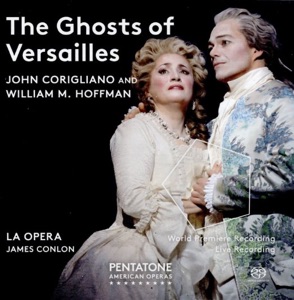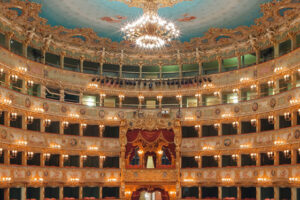

In the intervening 25 years, I’ve only known the opera by name, never having heard a note. So, when La Cieca asked me to write a review of the new audio recording, taken from live performances at L.A. Opera, I said that I’d only be able to approach it from a fresh, newcomer’s perspective.
And that, my friends, is what I offer you today.
First, the story. Louis XVI, Marie-Antoinette, and a slew of their members of court are hanging out in the afterlife, bored with their existence. Enter the playwright Pierre Beaumarchais, who is in love with the queen, and who has hatched a plan to bring her back to life.
He will write a new opera (for sake of ease, Beaumarchais is an all-purpose “creator” so his plays are referred to as operas and Mozart and Rossini are not mentioned) called A Figaro for Antonia. Through this opera, he will change the course of history and the French queen will be saved and somehow brought back to life.
The plot of his new opera is essentially that of the third instalment of his Figaro trilogy, La Mère Coupable. The aristocrats of Louis XVI’s court are all bored and thus, happy to enjoy a new creation by Beaumarchais. Marie-Antoinette, on the other hand, receives the notion more seriously and takes the opportunity to relive her harrowing end in a rather large aria (“They are always with me”).
And so, the opera-within-an-opera begins, with Beaumarchais evoking different scenes on stage of the Versailles Opera House (which was built do celebrate the wedding of the unfortunate king and queen). The opera brings back all of our favourites—Almaviva, Rosina, Figaro and Susanna. Cherubino, now dead, makes an appearance in a flash-back in the opera-within-the opera.
There is also the villain Bégearss, an homage to Moliere’s Tartuffe, who has been promised the hand of Almaviva’s daughter, Florestine, the result of an out-of-wedlock tryst. But she’s in love with Léon, who is the son of Rosina’s love-child with Cherubino. In the course of the opera, they go through a series of zany events involving the sale of Marie-Antoinette’s necklace.
The plot, as Louis XVI remarks, is more complicated than the final act of Marriage of Figaro. But the premise is certainly interesting, even fascinating, so long as one doesn’t get too mired in the details.
There are many, many characters, as if the opera’s creators were determined to make the most of a limitless budget by stuffing as many people on stage as possible. The dialogue is sometimes clever but often in need of editing. And it is littered with utterances like “My dear madame” or “My dear Marquis” that lead to over-foppy delivery by the cast.
The opera consistently aspires to wit but achieves it better through music than words.
Corigliano clearly enjoys visiting the world of yesteryear, drawing inspiration from two centuries’ worth of music. Very early in the piece, there are a few immediate quotes—a bit from the overture to Nozze di Figaro here, a lick from Rossini’s “Largo al factotum” there.
This was concerning at first, because I’m weary of works that rely too heavily on musical quotations. But thankfully, Corigliano leaves the musical quotes mostly alone and instead writes in what can be best described as free-form neo-style.
The opera opens with stark, atonal writing. (I can imagine rueful mutterings from some of the opening night Met audience members). But the music morphs constantly and Corigliano is truly eclectic in his choices. Most of the ghosts’ music is written in a 20th century idiom, most of it tonal, while the majority of the music for the opera-within-an-opera is neo-Classical and neo-Romantic. But the most remarkable aspect of it is the fluidity of this eclecticism.
In Figaro’s opening aria, Corigliano surveys a variety of musical styles, from Classical patter to Britten-esque vocal writing supported by a cushion of Mahlerian orchestra. In Rosina and Susanna’s second act duet, the orchestra hints at “Soave sia il vento” from Cosi fan tutte but the vocal lines are more at home in the 20th century. It’s this fluidity that keeps the work always musically interesting.
One of the most memorable sections of the opera is a quartet in the first act that displays both the cleverness of the libretto and Corigliano’s musical inspiration. As Marie-Antoinette and Beaumarchais watch the opera-within-an-opera, they observe Cherubino and Rosina in a moment of romance. The quartet is really a love duet sung by the two sets of characters.
The melody is one of the loveliest of the opera (it returns wistfully in the orchestra during opera’s closing pages), built out of the opening notes of Mozart’s “Voi che sapete” and is first delivered by Cherubino. This combination of imagination and beauty represents the work at its best.
The opera is at its strongest when it is being clever. Figaro’s introductory aria is notable not only for how nimbly it straddles different musical styles but also for how well it portrays one of the most familiar characters in the entire canon. He is older now and less carefree now but Hoffman and Corigliano give him an aria worthy of his reputation.
They also indulge in a typical facet of 18th and 19th century opera—Orientalism. So, we are taken to the Turkish embassy in Paris where we meet the singer Samira. Whatever one’s views about Orientalism as a device in a 20th century opera, the showpiece for Samira is inspired.
Though the comedy is largely successful, it could do with some pruning. I could have done with a lot less of the Woman with Hat. It doesn’t help that in Victoria Livengood’s assumption, the character becomes a tedious caricature of an old queen. But the opera’s creators clearly love her, giving her one prominent punch-line after another. They even have her trotting out in a Valkyrie helmet at the climax of the first act to declare that Wagner is the best. I can’t help but think that is just so Corigliano can work in a passing reference to Tristan in the orchestra.
The piece is best enjoyed as a grand amusement. There is richness in the material but not a lot of depth. The details are wonderful and numerous but the emotional impact is limited mainly to the Marie-Antoinette character. Even the would-be love story between her and Beaumarchais feels false.
When it strives for emotional depth, the opera doesn’t quite hit the mark. When Hoffman has Beaumarchais restaging Marie-Antoinette’s trial as a way of convincing Figaro to return the necklace to Almaviva so he can in turn sell it to the English Ambassador to save the queen’s life (Gee, I hope I got the details right), the resulting scene feels like a divertissement. Except that it isn’t a divertissement; it is supposed to be one of the most emotionally charged sequences of the opera.
As the story turns serious, the opera weakens, especially the prison scene that follows Marie-Antoinette’s trial. There’s a striking, Britten-esque quintet which provides musical interest, but on the whole, the piece drags.
There’s nothing wrong necessarily with taking a serious turn in the second act but the drama fails to move. If the opera is to have any emotional resonance, it going to be achieved through Marie-Antoinette. (It is easy to see why Teresa Stratas was given the role in the opera’s premiere).
One can argue that a soprano just has to show up and sing the notes written for Violetta or Cio-Cio San and the audience will be moved to tears. Here, despite giving Marie-Antoinette lots of big moments and delving into the most painful moments of her demise, Corigliano and Hoffman aren’t able to catch emotional fire with the character’s storyline.
What I admire most about the work is Corigliano’s skill as an opera composer. Whereas so many contemporary composers in recent times have offered over-orchestrated instrumental writing and half-baked vocal writing, Corigliano is at home writing for both orchestra and voice. He responds to a multitude of dramatic situations with a rich variety of music and stays on top of the some two dozen characters.
The orchestration brings the story ebulliently to life without veering into self-indulgence. Corigliano is at his most inspired in lively, spirited music, whether it’s the swift strings depicting Figaro running from his debtors or the energetic rhythms of Samira’s cabaletta. While he does a good job of depicting the weary, drowsy atmosphere of the ghosts’ existence, the prominent use of Theremin is a serious misfire (Oooh! Ghosts!!)
Despite the many solo players in the opera, much rests on the shoulders of the soprano portraying Marie Antoinette. She is more than the lead role; she is crucial to the work’s dramatic success.
Patricia Racette gives a committed and sincere performance. Vocally, she is in late-career form and her high notes suffer from a wobble and squally tone, but she sings the difficult music valiantly, digging into her chest voice for the many low notes and rising confidently to the multiple high-lying climaxes. While she achieves emotional depth in some moments, especially the opening and closing arias, her performance on the whole lacks glamour or grandeur. And she can’t quite pull off the tough assignment of carrying the opera’s emotional arc.
As Beaumarchais , baritone Christopher Maltman pretty much hits all the marks without achieving real distinction. The voice is attractive, the singing commendable, and he does not cheat the words, but the performance lacks face.
Vocally, the most impressive work comes from Lucas Meachem, a charming (if too hammy) Figaro. He possesses a robust baritone with huge high notes. I’d love to hear him in some Donizetti and Verdi. In his introductory aria, he immediately establishes the character and gives a bravura performance.
With her beautiful, creamy voice and her fluid singing, Guanqun Yu’s Rosina evokes Renee Fleming who created the role at the work’s premiere. Her Almaviva, tenor Joshua Guerrero brings an attractive tenor and clean diction.
Mezzo soprano, Lucy Schaufer, sounds matronly as Susanna while Stacey Tappan sings the young Florestine with a silvery, crystalline soprano. Her love interest Leon is delivered in a bright, vibrant tenor by Brenton Ryan, with hints of heldentenor possibility. He’s one to watch.
In the pivotal land juicy role of the villain Bégearss, tenor Robert Brubaker is a mixed bag. Dramatically, he is on the right on the money, delivering his lines with clear diction and creating a vivid portrayal. Vocally, it’s a different matter. He conquers the role’s high tessitura but the effort shows. And while his high notes are penetrating, Brubaker’s strained vocal emission is stressful to listen to.
As his bumbling servant Wilhelm, Joel Sorenson is appropriately amusing and bumbling, delivering his lines with a heavy German accent.
In the cameo role of Samira, Patti LuPone brings all her vocal mannerisms—the bent vowels, the snarling out the side of her mouth. But she phrases her cavatina alluringly and delivers a performance of undenialble, kitschy exuberance.
James Conlon leads a vivid a performance, providing excellent support to his singers while taking evident joy in the music’s more lively sections.
This is a good opera and I am happy to make its acquaintance. A number of its tunes have wormed their way into my ear and the story is engaging. But for all its skill and impressive detail, The Ghosts of Versailles is less than the sum of its parts.

























Comments